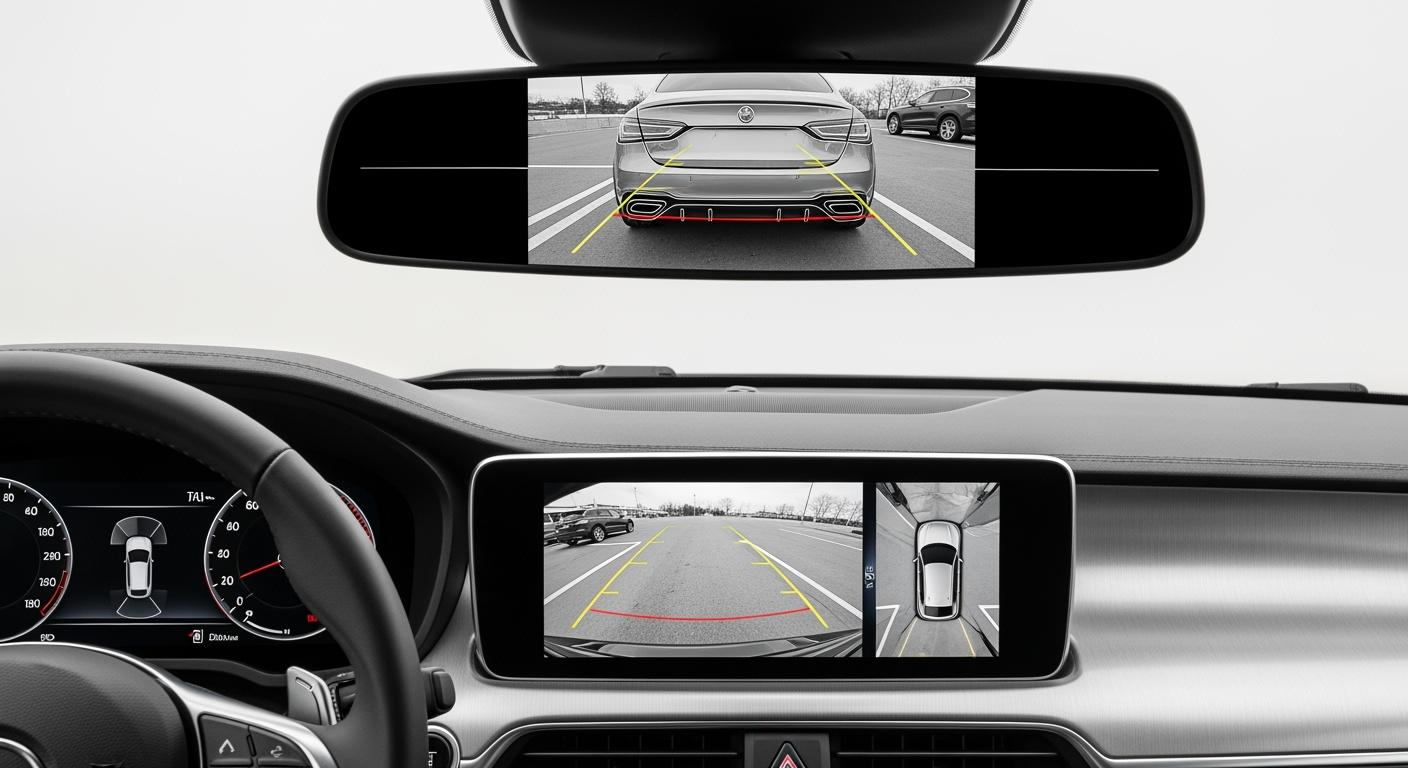
The main differences between a rear view mirror camera and a traditional reversing camera are in how they show what is behind your car. A rear view mirror camera shows a live, wide picture on your mirror. A traditional reversing camera shows video on a screen in the dashboard. These changes help keep you safe and help you see better. Many drivers now pick advanced camera systems. Studies show these cameras can cut backover crashes by up to 50%. This change is making drivers see and react differently to what is behind them on the road.
Key Takeaways
- Rear view mirror cameras let drivers see all the time. They help you see more than just what is behind you. This makes lane changes and parking safer.
- Traditional backup cameras turn on only in reverse. They show a smaller area. These cameras help with parking. But they do not give as much information as rear view mirror cameras.
- Buying a rear view mirror camera can lower accident risk by half. This makes it a smart safety choice for any car.
- Both types of cameras need care. Rear view mirror cameras often have extra features like night vision and ADAS alerts. These features help in many driving situations.
- Think about how you drive before you pick one. If you park in small spaces or drive big cars, a rear view mirror camera might be best.
Quick Comparison Table
Feature Overview
When you compare rear view mirror cameras and traditional backup cameras, you can spot some clear differences. Rear view mirror cameras show a live, wide picture right on your mirror. You can always see what is behind you, not just when you are backing up. Traditional backup cameras only work when you put your car in reverse. They show a smaller view on a screen in your dashboard.
Here’s a quick table to help you compare these two systems:
| Feature | Backup Camera | Rear View Mirror Camera |
|---|---|---|
| Primary Purpose | Helps with reversing and parking | Gives you continuous visibility |
| View Coverage | Shows area directly behind the car | Shows a wider view, including sides |
| Activation | Turns on in reverse gear | Always on, replaces your regular mirror |
| Extra Features | Parking guidance lines | Can add parking sensors and safety alerts |
| Best Use | Parking and reversing | Lane changes, driving, and parking |
Tip: Rear view mirror cameras help make driving safer. You get a clear and steady look at what is behind you, even in heavy traffic or tight spaces. This helps you avoid accidents and makes parking easier, especially if you drive a large car or SUV.
Let’s look at the details:
-
Backup Camera:
- Only works when you are in reverse.
- Helps you park straight with guidance lines.
- Gets rid of blind spots right behind your car.
-
Rear View Mirror Camera:
- Always stays on, so you see more.
- Makes lane changes safer by showing a bigger area.
- Can work with other safety systems for extra alerts.
A rear view mirror camera might be better for you if you want more safety and awareness every day. If you just need help parking, a backup camera could be enough.
Visibility with Rear View Mirror Camera
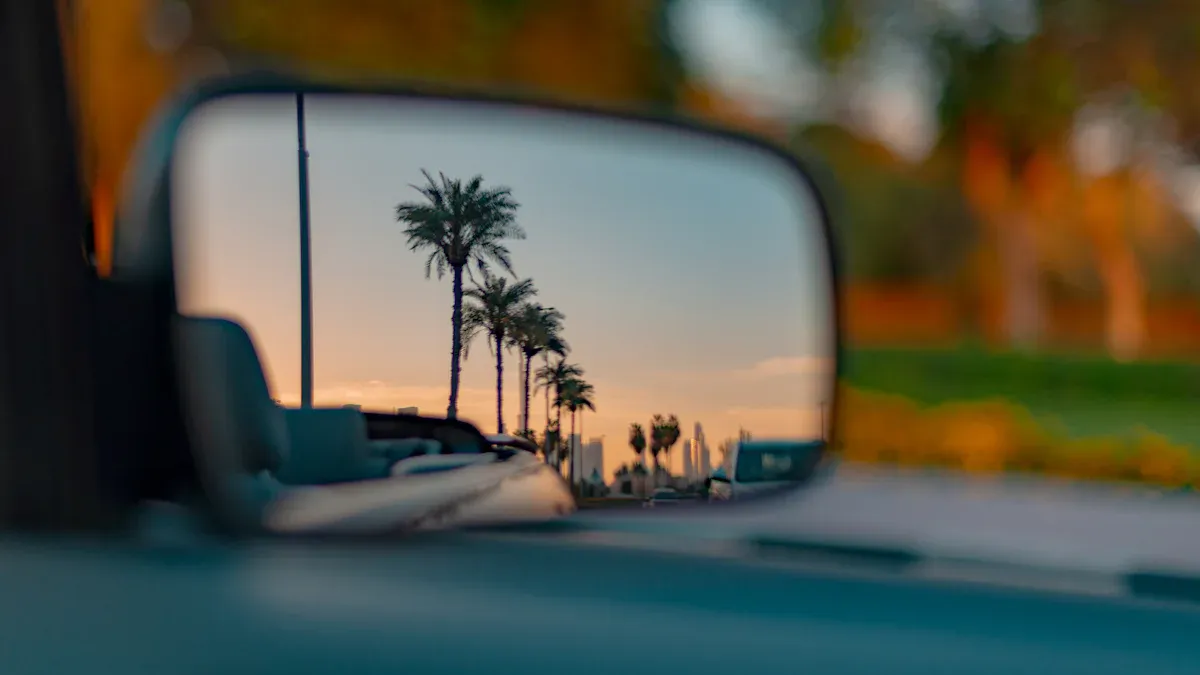
Field of View and Clarity
When you drive, seeing as much as possible behind your car can make a big difference. A rear view mirror camera gives you a much wider look at what’s happening behind you compared to a traditional backup camera. You don’t just see what’s right behind your bumper—you also catch the sides, which helps you spot cars, bikes, or people that might sneak into your path.
Here’s a quick look at how the field of view stacks up:
| Camera Type | Field of View Characteristics |
|---|---|
| License Plate Backup Camera | Up to 170 degrees horizontal, limited vertical coverage |
| Traditional Rearview Camera | Higher positioning, better depth perception, narrower horizontal view |
With a rear view camera, you get a wide-angle lens that covers more ground. This means you can almost erase those annoying blind spots that make lane changes or parking tricky. Many drivers say the always-on display helps them feel safer, especially in big vehicles like SUVs or trucks. You don’t have to wait until you shift into reverse—the rear view mirror camera keeps you aware all the time.
You’ll also notice the image looks sharper and clearer. The electronic mirror adjusts for things like bright sunlight or shadows, so you see details even when the lighting changes fast. Here’s what makes the clarity stand out:
- The camera system uses a high-definition display, so you see crisp images even in busy parking lots.
- It balances the light and color, so you don’t get blinded by headlights or lose sight in the shade.
- The wide-angle lens helps you spot obstacles and people, making it easier to avoid accidents.
Tip: If you often park in tight spaces or back out of busy driveways, a rear view camera can help you spot things you might miss with a regular mirror.
Night and Weather Performance
Driving at night or in bad weather can make it tough to see what’s behind you. A rear view mirror camera really shines in these moments. The camera uses special technology to brighten up dark scenes and cut through glare from headlights. You get a clear view, even when it’s raining or foggy.
Here’s how a rear view camera helps you in tough conditions:
- Night vision features let you see clearly after sunset, using sensors that pick up more light.
- The camera reduces glare, so headlights from other cars don’t blind you.
- Waterproof and weather-resistant designs keep the camera working, even in heavy rain or snow.
- The system balances the light, so you don’t lose sight of obstacles in bright or dark spots.
Many drivers say they feel more confident driving at night or during storms because the rear view camera gives them a reliable view. You can spot pedestrians, animals, or objects that might be hiding in the shadows. This extra visibility helps you avoid surprises and keeps everyone safer.
If you want a camera that works well in all kinds of weather and lighting, a rear view mirror camera is a smart choice. You get a bigger, clearer picture and fewer blind spots, no matter what the road throws at you.
Ease of Use and User Experience
Daily Driving Integration
When you drive every day, you want things to feel easy and natural. If you use a backup camera, you only see the video when you shift into reverse. You look at the dashboard screen for a quick check, then go back to your regular mirror for the rest of your trip. This feels familiar because you already know how to use mirrors.
Switching to a rear view mirror camera changes your routine. The screen replaces your old mirror, so you see a live video all the time. At first, this can feel strange. Your eyes need to adjust because the focus distance is different from a regular mirror. You might find yourself reaching for the old mirror out of habit. Some drivers say it takes a little while to get used to the new display. You may feel a bit awkward checking blind spots or glancing at the screen. But after a short learning curve, most people find that their awareness improves. You start to notice more details behind and beside your car, which helps you stay safer.
Note: Studies show that camera monitor systems like the rear view mirror camera help drivers spot cars and bikes more easily. You get better situational awareness, which means fewer surprises on the road.
Rear View Mirror Backup Camera in Parking
Parking can be stressful, especially in tight spots or busy lots. A backup camera helps you line up your car and avoid hitting things. You see guidelines on the screen, which makes parking easier. You only use it when you reverse, so you still rely on your mirrors for other moves.
With a rear view mirror backup camera, you get a wide-angle view every time you park. The display stays on, so you can check your surroundings before, during, and after parking. You see more of the area behind your car, including the sides. This helps you spot people, pets, or objects that might be hard to see with a regular mirror. You don’t have to switch between screens or mirrors. Everything you need is right in front of you.
- You adapt quickly to the new system.
- You feel more confident in crowded parking lots.
- You spend less time worrying about blind spots.
If you want a smoother parking experience and better visibility, the rear view mirror backup camera can make your daily routine easier.
Installation and Compatibility
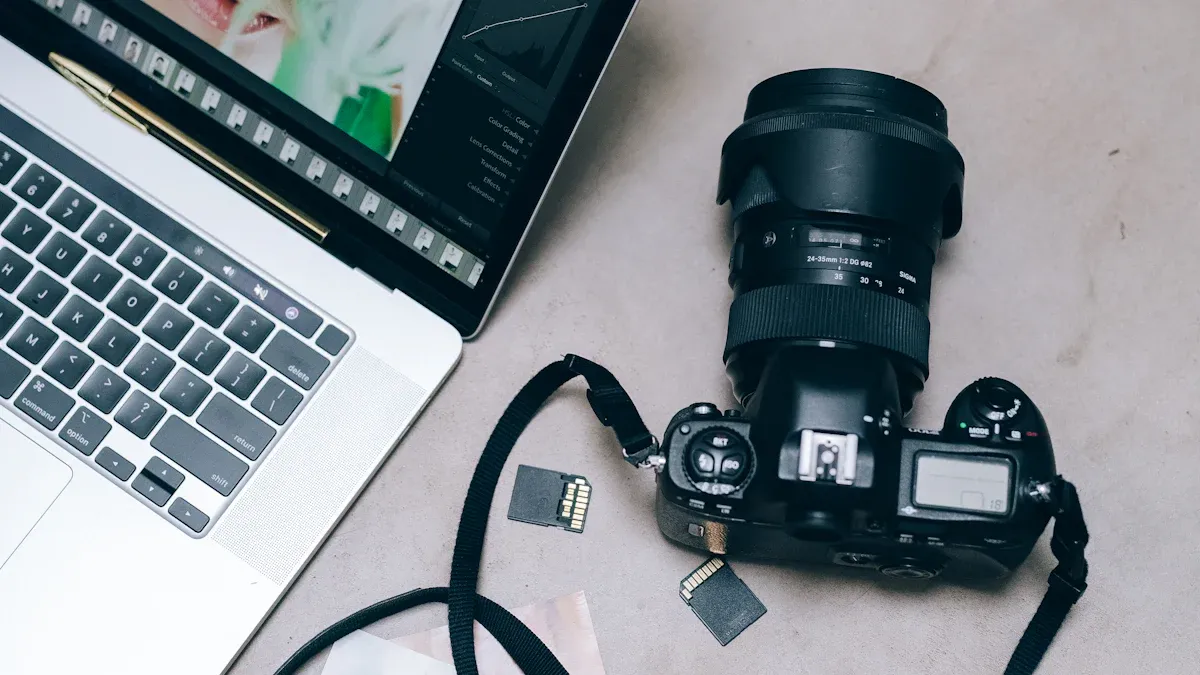
Rear View Camera Setup
Setting up a rear view camera can feel like a big job, but you can break it down into simple steps. Most kits come with everything you need. Here’s what you usually do:
- Plan where you want to run the cables.
- Mount the camera, often near your license plate.
- Connect the camera to your car’s power and video system.
- Test the camera to make sure it works.
You might need some tools, like screwdrivers, trim removal tools, and a power drill. Some people use a multimeter or wire stripper, too. If you have an older car, you can still add a rear view camera. The process is pretty straightforward, and it helps you see better when you back up.
Tip: If you don’t feel comfortable with wiring, you can always ask a professional for help.
Rear View Mirror Backup Camera Installation
Wondering how to install a rear view mirror backup camera? The steps look a lot like the ones for a regular backup camera, but you’ll also replace your old mirror with a new screen. Here’s a quick list:
- Remove your old rear view mirror.
- Mount the new mirror with the built-in display.
- Run the camera cable from the back of your car to the mirror.
- Connect the power and video wires.
- Hide the cables using trim or cable clips.
- Test the system to make sure everything works.
Most rear view mirror backup cameras work with many car models, even older ones. You might find that running wires takes time, especially if you want everything hidden. Some people say hardwiring can be tricky and takes patience. If you don’t have DIY skills, a pro can do the job for you.
Both camera types help you see more and make driving safer. You can upgrade almost any car, new or old, with these systems.
Safety and Advanced Features
ADAS and Alerts
When you drive, you want to stay safe. Advanced Driver Assistance Systems (ADAS) help with this. Rear view mirror cameras with ADAS give you alerts right away. These alerts warn you about accidents before they happen. You get a warning if a car or person moves behind you. You also get alerts if you drift out of your lane. This helps you react quickly and avoid crashes.
Let’s see how these features compare:
| Feature | Advanced Safety Features (ADAS) | Traditional Backup Cameras |
|---|---|---|
| Cross-Traffic Alerts | Yes | No |
| Parking Sensors | Yes | No |
| Integration with ADAS | Yes | No |
| Real-Time Alerts | Yes | No |
| Ultrasonic Sensors | Yes | No |
| Radar and LiDAR Integration | Yes | No |
| Comprehensive Surround View | Yes | Limited |
With a rear view mirror camera, you get more than a picture. The system helps you spot dangers and avoid crashes. For example, cross-traffic alerts warn you if a car is coming when you back out. Parking sensors beep if you get too close to something. Some systems use radar or LiDAR to watch for moving things. This extra safety is helpful in busy parking lots or crowded streets.
The Botslab Dash Cam G980H Pro has even more features. It has a 4K front camera and a 2K rear camera. You see every detail. The rear camera can turn all the way around. You get a full view behind your car and inside. This helps you spot accidents before they happen. The ADAS system gives you alerts for lane changes, people moving, and driver tiredness. Voice control lets you keep your hands on the wheel. You can say commands like “show rear camera” or “take photo” without looking away.
Tip: Real-time alerts and ADAS features warn you about dangers you might not see in your mirrors. These systems work all the time, not just when you back up.
Pedestrian and Object Detection
Pedestrian and object detection helps stop accidents. Rear view mirror cameras with advanced detection can spot people, animals, and things behind your car. This helps you avoid crashes in parking lots, driveways, and busy streets. Traditional backup cameras only show what’s behind you. They don’t warn you if someone steps into your path.
Here’s why advanced detection is special:
- Rear view mirror cameras give you a wide view behind your car, so you see more.
- HD surround vision makes a digital overhead image, so it’s easier to spot people and things.
- Rear cross-traffic braking can stop your car if it senses danger.
- These systems use smart sensors and cameras to watch for movement, even in blind spots.
Recent safety tests show pedestrian detection is getting better. It helps you avoid accidents by spotting people who move behind your car. The system can tell if someone is walking or running. This helps you react faster. Some systems use smart training models to get more accurate. They look at lots of data to learn what people and things look like from different angles.
You might get a few false alarms, but these systems still help prevent accidents. The chance of missing real danger is low. Most drivers feel safer knowing the system is always watching for accidents.
The Botslab Dash Cam G980H Pro uses Sony IMX415 and Starvis sensors for clear images, even at night. You get sharp video and good detection, day or night. The built-in GPS tracks your route and speed. This can help if you need proof after an accident. The 24-hour parking mode keeps your car safe, even when you’re not there. You get alerts if someone tries to break in or if another car bumps into yours.
Note: Advanced detection systems help you avoid accidents by watching for people and things in your blind spots. You get more peace of mind, whether you’re driving or parked.
With all these features, rear view mirror cameras help you avoid accidents, spot dangers in your blind spots, and keep your family safe. You get more than just a camera—you get a smart safety system that works for you every day.
Cost and Value
Upfront and Long-Term Costs
When you look for a rear view mirror camera or a traditional backup camera, price is important. Rear view mirror cameras usually cost more at first. They have extra features and better visibility. Here’s a table that shows the price ranges for rear view mirror cameras:
| Price Range | Number of Items |
|---|---|
| $100.00 - $199.99 | 2 |
| $200.00 - $299.99 | 6 |
| $300.00 - $399.99 | 5 |
| $400.00 - $499.99 | 1 |
| $500.00 - $599.99 | 1 |
| $600.00 and above | 1 |
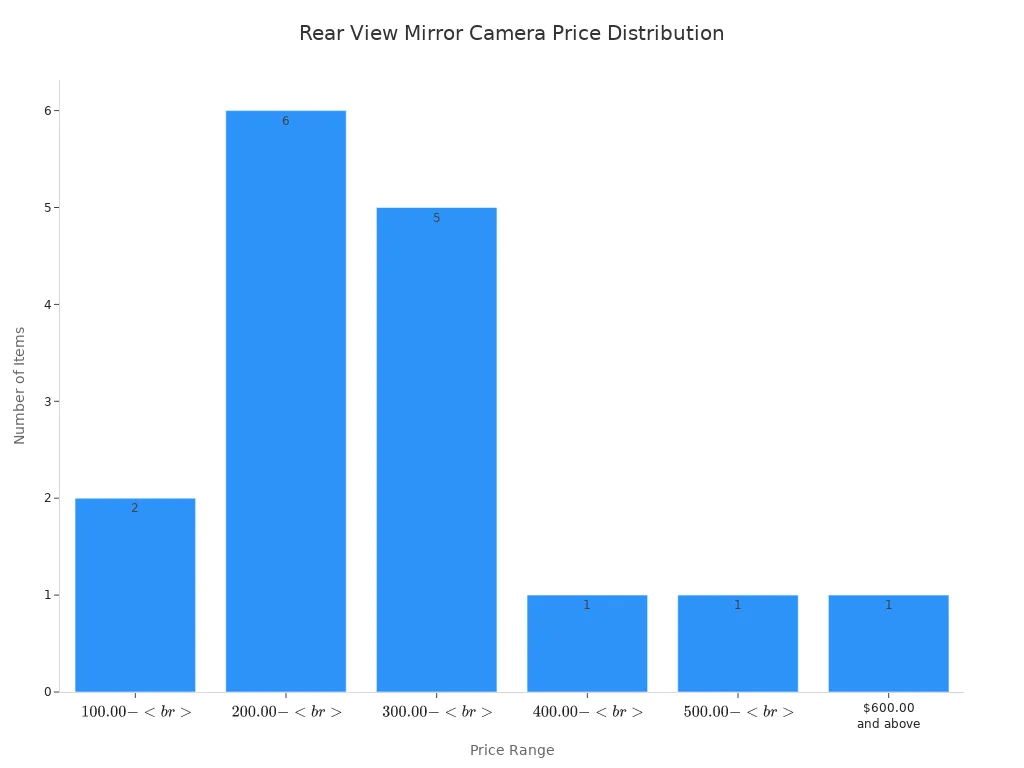
Most rear view mirror cameras cost between $200 and $400. Traditional backup cameras are usually cheaper. They may not have as many features. When you think about long-term value, remember rear view mirror cameras can help you avoid accidents. This could save you money on repairs later.
Tip: Paying more at first for a rear view mirror camera can be worth it. You get more safety and convenience every day.
Maintenance and Durability
Both camera types need care to keep working well. You might have some problems, like dirty lenses or loose wires. Here’s a table that shows what to watch for:
| Component/Issue | Description |
|---|---|
| Camera Lens | Prone to dirt, moisture, or scratches affecting image quality. |
| Wiring and Connectors | Issues with dust, pixel fading, or connectivity affecting monitor display. |
| Power Supply | Damage to connections, fuses, or batteries can lead to system failure. |
| Mounting Hardware | Loosening or misalignment due to vibrations and impacts. |
| Storage Devices | SD cards or internal memory may fill up or corrupt over time. |
| Night Vision Elements | Dust or damage to LED/IR lights can threaten visibility at night. |
| Blurry images | Caused by scratched or dirty lenses; can be fixed by cleaning. |
| Black Screens | Result from connection or power issues; check fuses and wiring. |
| Flickering Video In Feed | Caused by signal interference or loose wires; tighten connectors. |
| Static or Delays | Weak wireless signal in RVS; consider upgrading the signal receiver. |
| Distorted Night Vision | Caused by damaged or dirty IR lights; clean or replace as necessary. |
| Washed out or Glare Image | Caused by sunlight or incorrect settings; adjust camera angle and settings. |
You can fix most problems by cleaning or checking the wires. Both systems last a long time if you take care of them. Here are some things to remember about durability:
- Rear view mirror cameras use screens and cameras that face tough weather.
- Some people wonder if these systems last as long as regular mirrors after years.
- Both camera types can handle daily use, but you should check them sometimes to make sure they work.
If you want your camera system to last, clean the lens, check the wires, and update the software when needed. This helps you get the most value from your camera.
Pros and Cons of Rear View Camera Systems
Rear View Mirror Camera Pros and Cons
When you think about adding a rear view mirror camera to your car, you probably want to know what’s good and what’s not so great. Many drivers like these cameras because they make driving feel safer and easier. You get a wide view behind your car, which helps you spot things you might miss with a regular mirror. The rear view mirror camera also works well in bad weather, so you can see clearly even when it rains or snows. Some experts say these cameras can even help your car use less fuel because they improve aerodynamics.
But there are a few things you should know before you switch. The rear view mirror camera gives you a flat, two-dimensional image. This can make it harder to judge how far away things are. Sometimes, the camera’s resolution is not as sharp as a regular mirror, which can make it tricky to see small details. If something breaks, repairs might cost more because of the electronics. You also need a little time to get used to looking at a screen instead of a mirror.
Here’s a quick table to help you see the main pros and cons:
| Pros | Cons |
|---|---|
| Better aerodynamics and fuel efficiency | Flat image affects depth perception |
| Great visibility and safety in traffic | Lower resolution can impact distance judgment |
| Works well in bad weather | Repairs may cost more |
| Meets safety rules | Takes time to get used to screen display |
Tip: If you want better visibility and safety every day, a rear view mirror camera can be a smart upgrade.
Traditional Backup Camera Pros and Cons
A backup camera has helped many drivers park with confidence. You get a clear view right behind your car, which makes parking and hooking up trailers much easier. You can avoid blind spots and feel more relaxed when driving in tight spaces. Most backup cameras are easy to set up, and some even give you beeps or warnings if you get too close to something.
Still, there are a few downsides. The image quality might not be the best, especially if the lens gets dirty. Sometimes, wireless cameras have signal problems. You might get distracted by the bright display or feel too confident and forget to check your mirrors. Wired installations can also be a bit tricky.
Here’s a table to show you the main points:
| Pros | Cons |
|---|---|
| Easier parking | Image can be low quality |
| More confident driving | Lenses get dirty |
| No more blind spots | Wireless signal can drop |
| Good for trailers | Wired setup can be hard |
| Audible warnings | Can cause distractions |
| Simple to install | Display can be too bright |
Note: A rear view camera or backup camera can both help you drive safer, but each has its own strengths and weaknesses.
Choosing the Right Camera for You
Everyday Drivers
If you drive to work, school, or run errands, you want a camera system that feels easy and safe. Rear view mirror cameras give you a simple way to boost your safety. You can install one quickly, and it works as both a mirror and a camera. This dual-purpose design helps you see more without adding extra gadgets to your dashboard. You get a wider view, which means fewer blind spots. When you understand the differences between a backup camera and a rear view mirror camera, you can pick the one that fits your needs best. If you want something discreet and effective, a rear view mirror camera might be the right choice.
Tip: Try a rear view mirror camera if you want better visibility all the time, not just when you park.
Families and Rideshare
Do you drive with kids or give rides to others? Safety matters even more. Families and rideshare drivers need to see everything around their car. Some rear view mirror cameras, like the AUTO-VOX V5 Pro, offer features that help you stay safe. You get dual video, GPS tracking, and parking help. These features let you watch for people, pets, or bikes near your car. The camera blends into your car’s design, so you don’t get distracted. You can focus on driving while the camera keeps an eye out for danger. If you want extra peace of mind, look for a camera with smart safety tools.
- Dual video helps you see inside and outside.
- GPS tracking shows where you’ve been.
- Parking help makes tight spots easier.
Budget Considerations
Money plays a big role in your decision. Rear view mirror cameras often cost more up front. You pay for extra features and better visibility. Backup cameras usually cost less and still help you park safely. If you want to save money, start with a basic backup camera. If you want more safety and smart features, consider spending a bit more on a rear view mirror camera. Think about what matters most to you—price, safety, or convenience.
| Camera Type | Best For | Price Range |
|---|---|---|
| Backup Camera | Budget shoppers | $50 - $150 |
| Rear View Mirror Camera | Safety and convenience | $200 - $400+ |
Note: Choose a camera that fits your budget and your driving style. You don’t have to spend a lot to get better safety.
Rear view mirror cameras let you see more behind your car. They work well at night and have smart safety tools. Backup cameras help you park and back up, but they show a smaller area. Here’s a table to help you choose:
| Camera Type | Functionality | Best For |
|---|---|---|
| Backup Camera | Focused view for reversing and parking safety | Drivers needing help while reversing |
| Rear View Camera | Continuous visibility for overall awareness | Urban drivers or those with larger vehicles |
If you want extra safety and new features, choose a rear view mirror camera. If you just need help parking, a backup camera is a good choice. 🚗
FAQ
How hard is it to switch from a regular mirror to a rear view mirror camera?
You might need a few days to get used to the new screen. Your eyes will adjust quickly. Most people say it feels natural after a week of daily driving.
Can I install a rear view mirror camera in an older car?
Yes, you can! Most rear view mirror cameras work with older cars. You just need to check the power source and make sure you have space for the new mirror.
Do rear view mirror cameras work at night or in bad weather?
Absolutely! These cameras use special sensors and night vision. You get a clear view even in rain, fog, or darkness. You will feel safer in all conditions.
Will a rear view mirror camera replace my backup camera?
A rear view mirror camera gives you a live view all the time. You can still use your backup camera for parking help. Many drivers use both for extra safety.



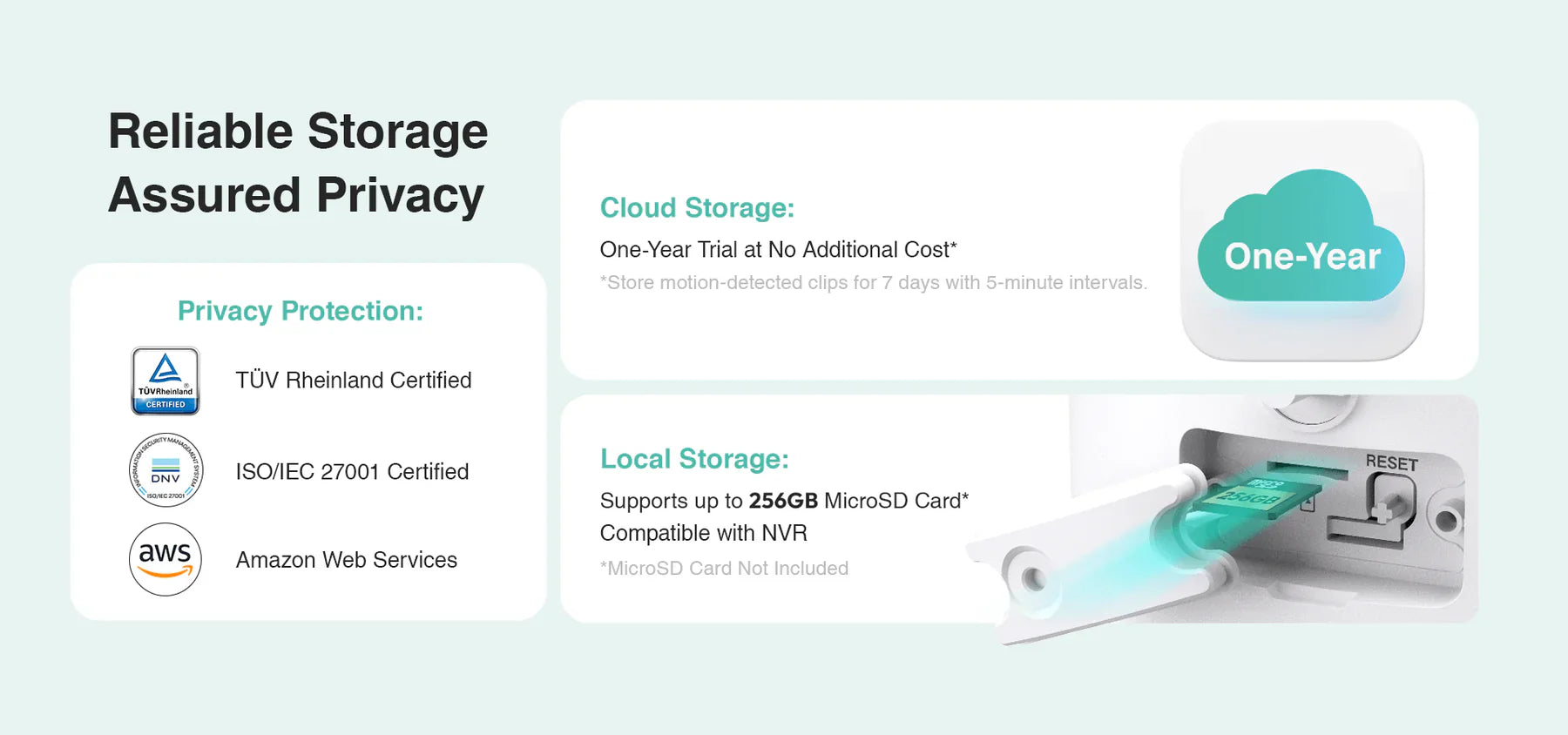

Share:
Top Dash Cams with Parking Mode for Every Budget
Outdoor Security Cameras Compared Wired and Wireless Options